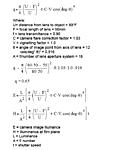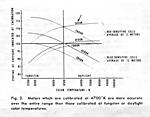There are two ways of thinking about film speed, speed as a property of a photographic emulsion, and speed as a practical approach to have as an index to enter into a meter.
From Jack Holm, "Mononumeric speed values provide information about the predicted output at only one point on the characteristic curve. If a speed value is based on shadow density, it will predict only the exposure required to produce that density, and similarly for highlight and other speed point exposure criteria. Also, typical light meters can only read one luminance value for a scene and thereby predict only one film plane exposure. The actual tone reproduction is therefore dependent on: the speed point exposure, the metered exposure, the desired reproduction of the metered exposure, and the difference between the speed point and metered exposures."
This can be seen in the relationship between the exposure constants: P = K * q
P = Exposure constant
K = Exposure meter constant
q = Exposure equation constant
What I've seen in ISO norms is a regular way to calculate speed. Speaking about BW, there is a rule that says where (irradiance amount) the linear line starts, with normal contrast, and then we have 3 1/3 stops at right to the grey card irradiance. There is something not strict or ruled: the developer used for the calibration. The exposure meters have a variability of 1/6 stop (IIRC) from ISO min/max recommended K factors.
That "speed as a practical approach to have as an index to enter into a meter", of course, depends on our metering and our process...
So at the end the thing works well, we have an ISO reference, and a practical usage from that reference, what you quote from Holm explains it very well...
Real quick on K. K is a constant used in the calibration of exposure meters. It can be considered a light loss constant.
Within the K equation are the elements of the equation to determine the constant q which is part of the camera exposure equation.

And if you look carefully at the equation for K, you can see the exposure constant P designated as K1.
K in part takes into consideration with hand held meters the light loss of the camera's optical system, the target camera illuminance, and any discrepancies created by the meter. The biggest factor being the spectral sensitivity of the meter's photo cell. A selenium cell can have values of r from 1.0 to 1.2 which can create a value of K from 12.5 to 15.0. 12.5 for K is considered the average value where the variables associated with the exposure meter all equal 1.

Last edited by Stephen Benskin; 21-Jun-2017 at 22:44.
It is interesting to see how complex are K and q for technicians. I think I finally undertood these formulas. Fortunately photographers don't need to make the calualtion in that way
Also it happens that TTL metering bypasses a lot of of the calculation process...
True, it is theory, and I find understanding theory helps to avoid misconceptions. Adam's K factor conspiracy rant in The Negative is a good example. The exposure meter seeing 18% gray is another. The fixed density of 0.10 over fb+f is 4 stops down from the metered exposure, and on and on...
Last edited by Stephen Benskin; 22-Jun-2017 at 20:36.
Stephen, I'd like to discuss that, because I saw some discrepances.
If I take an spot meter, say a TTL for simplification (Nikon F5 in spot mode for example) and I point to grey card, then the irradiance the meter will recommend should be the point "5" in this chart you posted, does not ?

It actually does. That is what Holmes meant when he referred to the importance of knowing the values and their relationships. The relationship between Hm and Hg (Hm/Hg), points 4 and 5 on Dunn's graph, is 10x (or 1.0 log-H, or 3 1/3 stops). I started working on a post about this. The importance is expressed in the constant's equation P = K * q. P is K1 in the K equation. 12.5 * 0.65 = ~ 8 (8.11). Factor that into the Sunny 16 equation then compare it to the value of Hm and you'll get 10.
Just to be clear, the note along side of point 5 stating "Statistical average scene with equivocal gray calibration surface" doesn't refer to 18% gray. Under the statistically average conditions, the metered exposure would be an equivalent of 12% reflectance. Now meters read Luminance not reflectance, so 12% is only what the equivalent reflectance would be under certain conditions. What a meter wants to really do is to create an exposure at the film plane of 8 / ISO.
Bookmarks